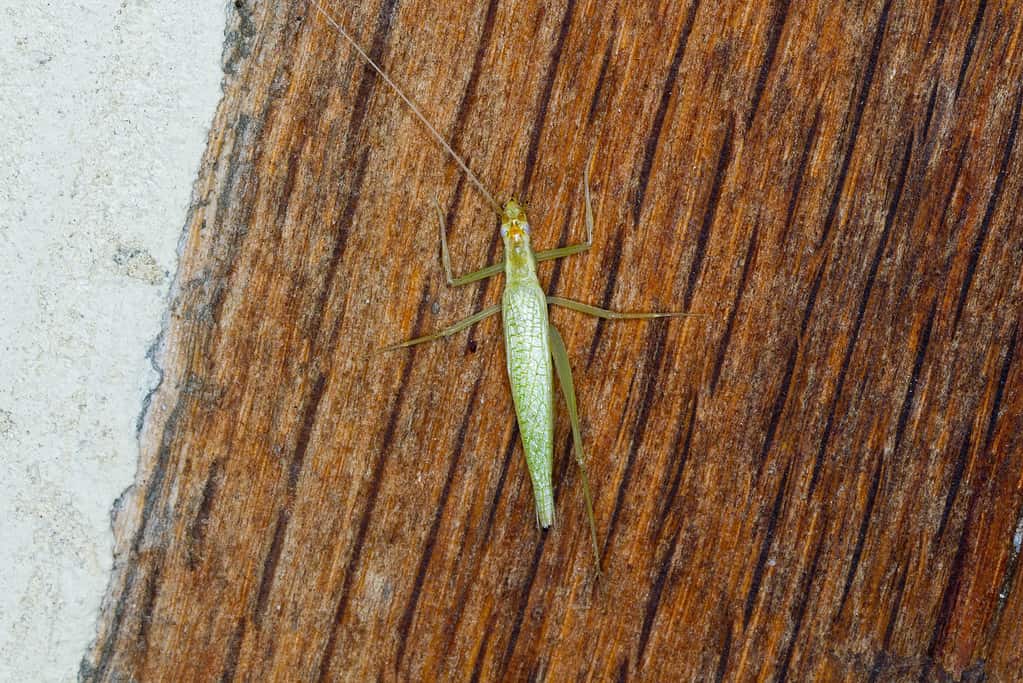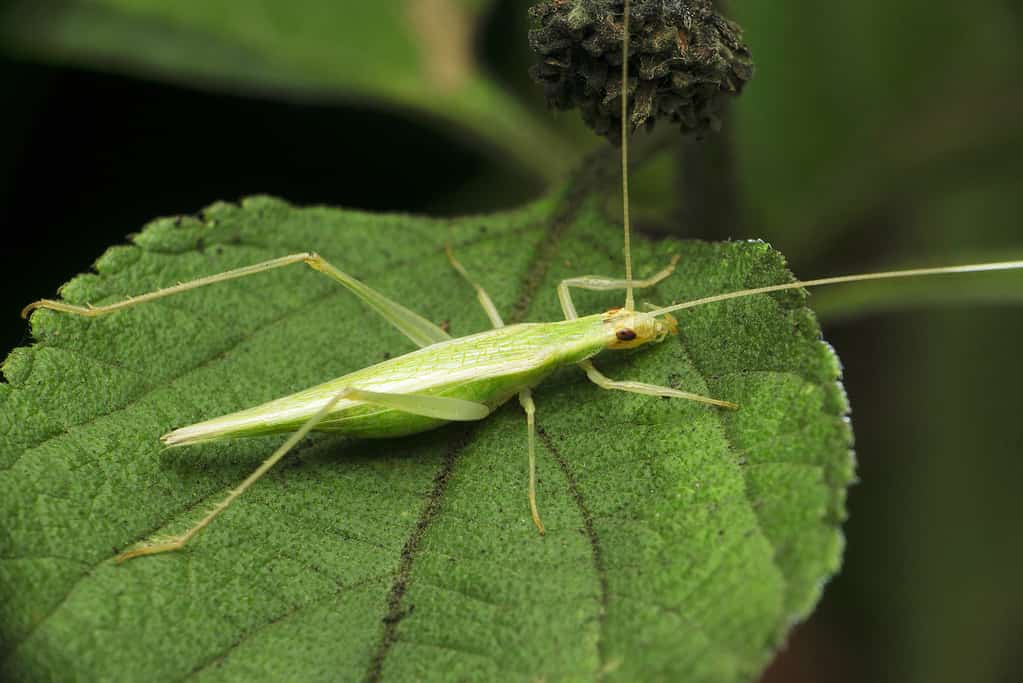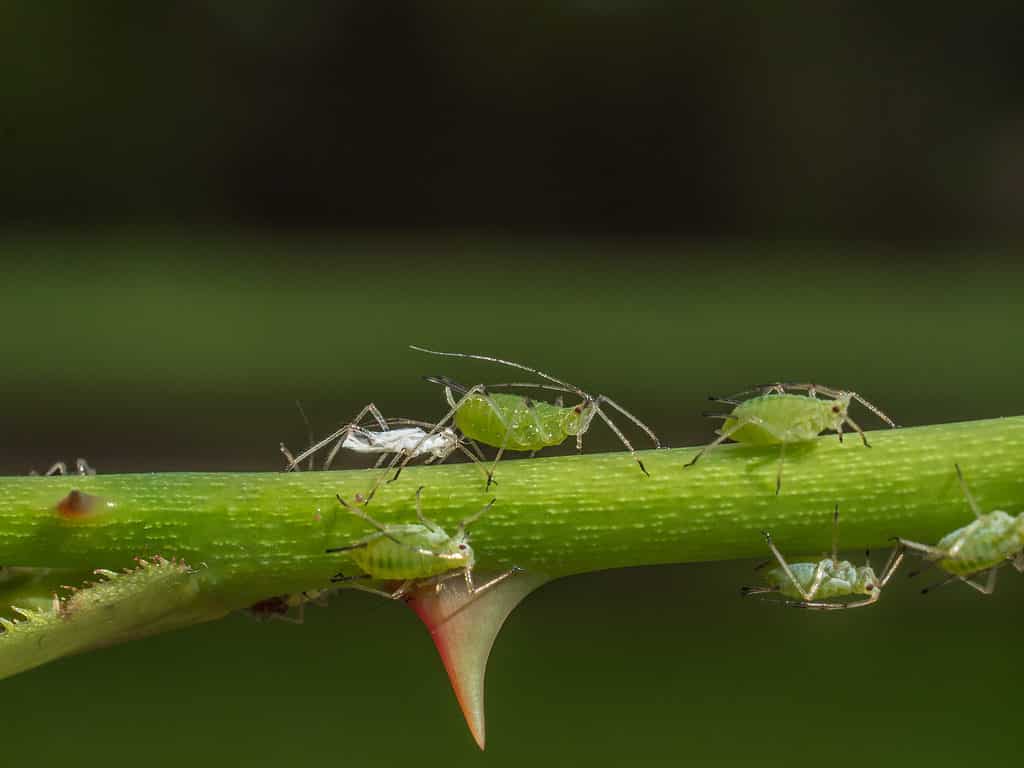Tree Cricket
The music of tree crickets is typically lower in pitch than the music produced by other cricket subfamilies!
Advertisement
Tree Cricket Scientific Classification
Read our Complete Guide to Classification of Animals.
Tree Cricket Conservation Status
Tree Cricket Facts
- Prey
- Soft-bodied insects like aphids
- Name Of Young
- Nymph
- Group Behavior
- Mainly solitary
- Fun Fact
- The music of tree crickets is typically lower in pitch than the music produced by other cricket subfamilies!
- Biggest Threat
- Habitat loss
- Most Distinctive Feature
- Ability to make musical noises with their wings
- Other Name(s)
- Pale bush cricket
- Habitat
- Trees, shrubs, herbs
Tree Cricket Physical Characteristics
- Color
- Green
- Skin Type
- Exoskeleton
- Lifespan
- Approximately 90 days
- Venomous
- No
- Aggression
- Medium
View all of the Tree Cricket images!
A tree cricket is any one of over 300 species within the subfamily Oecanthinae. These insects occur on every continent except Antarctica and live on trees, shrubs, and herbs. Although many species of crickets are considered pests, species within Oecanthinae are generally beneficial due to their habit of eating soft-bodied insects. They grow up to one inch in length depending on the species.
Species, Types, and Scientific Name

There are over 300 species of tree crickets belonging to the subfamily Oecanthinae.
©Elliotte Rusty Harold/Shutterstock.com
Tree crickets belong to the subfamily Oecanthinae. This subfamily divides into three tribes – Oecanthini, Paroecanthini, and Xabeini – as well as 26 genera. It belongs to the family Gryllidae (true crickets), the order Orthoptera (grasshoppers, locusts, crickets, and katydids), and the class Insecta (insects). As members of the phylum Arthropoda, these insects are invertebrate animals with exoskeletons.
There are over 300 species within Oecanthinae, including the following common examples:
- Snowy tree cricket (Oecanthus fultoni)
- Forbes’s tree cricket (Oecanthus forbesi)
- Davis’s tree cricket (Oecanthus exclamationis)
- Limpopo green tree cricket (Oecanthus galpini)
- Black-horned tree cricket (Oecanthus nigricornis)
- Prairie tree cricket (Oecanthus argentinus)
- Fast-calling tree cricket (Oecanthus celerinictus)
- Walker’s tree cricket (Oecanthus walkeri)
- Four-spotted tree cricket (Oecanthus quadripunctatus)
- Sage tree cricket (Oecanthus salvii)
- White sands tree cricket (Oecanthus beameri)
- Pine tree cricket (Oecanthus pini)
- Tamarack tree cricket (Oecanthus laricis)
- Narrow-winged tree cricket (Oecanthus niveus)
- Riley’s tree cricket (Oecanthus rileyi)
- Alexander’s tree cricket (Oecanthus alexanderi)
- Broad-winged tree cricket (Oecanthus latipennis)
- Western tree cricket (Oecanthus californicus)
- Different-horned tree cricket (Oecanthus varicornis)
- Texas tree cricket (Oecanthus texensis)
Appearance

The snowy tree cricket is known as the thermometer cricket because temperature can be estimated based on the number of their chirps.
©iStock.com/ePhotocorp
Tree crickets have three body segments – the head, thorax, and abdomen – with two lengthy antennae, compound eyes, and enlarged hind legs for jumping. The femora on these hind legs are thin while the hind tibiae usually have small teeth between their spines. Their heads are narrow with jutting mouthparts.
These insects also have two pairs of wings: leathery forewings and hind wings for flying. Using the scrapers on their front wings, they engage in a process called stridulation to produce their signature chirping song. This song tends to be lower in pitch than those of other cricket subfamilies. The snowy tree cricket is also known as the thermometer cricket because listeners can add 40 to the number of its chirps in 15 seconds to estimate the approximate temperature in Fahrenheit.
These insects differ in size according to species, but they range from 0.5 to 0.9 inches in length. They are usually pale green in color.
Habitat

Tree crickets live on trees, shrubs, and herbs on every continent except Antarctica.
©Christina Butler / Flickr – License
The tree cricket occurs on every continent in the world except Antarctica, which is too cold and barren to support it. In the United States, they occur in every state except Alaska.
In terms of habitat, these insects live on trees, shrubs, and herbs. Some common examples of plant life associated with them include red maple trees, apple trees, cedars, and goldenrod.
The table below includes various countries, islands, and regions with populations of tree crickets:
| North America | South America | Europe | Africa | Asia | Oceania |
|---|---|---|---|---|---|
| Canada | Argentina | Belgium | Algeria | Borneo | Australia |
| Costa Rica | Bolivia | Denmark | Canary Islands | China | Fiji |
| Guatemala | Brazil | France | Central African Republic | India | |
| Honduras | Colombia | Germany | Chad | Indonesia | |
| Jamaica | Ecuador | Greece | Democratic Republic of the Congo | Japan | |
| Mexico | Paraguay | Italy | Ghana | Jordan | |
| Nicaragua | Peru | Netherlands | Guinea | Lebanon | |
| Panama | Suriname | Portugal | Kenya | Malaysia | |
| Trinidad & Tobago | Uruguay | Spain | Libya | North Korea | |
| United States | Venezuela | Malawi | Palestine | ||
| Mozambique | Philippines | ||||
| Nigeria | Saudi Arabia | ||||
| Republic of the Congo | South Korea | ||||
| South Africa | Sri Lanka | ||||
| Uganda | Sumatra | ||||
| Thailand | |||||
| Vietnam | |||||
| Yemen |
Evolution and History
The order Orthoptera (grasshoppers, locusts, crickets, and katydids) has more than 25,000 extant species. Its origin goes back to the Carboniferous Period about 350 to 300 million years ago. Its two suborders, Ensifera and Caelifera, diverged during the Permian Period between 300 and 250 million years ago.
Within Ensifera, crickets diverged further from other orthopterans during the Triassic Period about 250 to 200 million years ago. This divergence continued throughout the Triassic and Jurassic. The oldest fossils from the family Gryllidae date back to the Early Cretaceous Period (145.5 to 65.5 million years ago). To date, scientists have discovered 38 fossil species from this family.
Diet

While tree crickets mainly consume plants, they will also eat aphids, making them a beneficial insect.
©Floki/Shutterstock.com
Although tree crickets primarily consume plant matter, they are technically omnivores. Like other crickets, they have a number of predators.
What Does the Tree Cricket Eat?
This insect primarily consumes plant matter like leaves, fruits, and other plant parts. It will even feed on fungi. However, it also preys on small, soft-bodied insects like aphids. Because of this, gardeners generally consider it a beneficial insect.
What Eats the Tree Cricket?
These insects fall prey to a wide variety of predators including birds, small mammals like rodents, reptiles like snakes and lizards, amphibians like frogs and toads, other insects, and spiders. Parasitic insects occasionally lay their eggs on the bodies of crickets, using them as a food source for their hatched larvae.
Prevention: How to Get Rid of Tree Crickets
Tree crickets can be either beneficial or harmful depending on the circumstance and the sex of the insect. Adults are beneficial in that they prey on insects like aphids, which cause damage to plants in large numbers. However, adult females also cause damage to twigs when placing their eggs. In addition to this, they produce trilling music at night that some people may find intrusive.
A simple bug spray should suffice to remove individual crickets from inside the house. Sticky glue traps may also help. However, for infestations, it is best to contact a professional exterminator.
Related Animals:
View all 133 animals that start with TThank you for reading! Have some feedback for us? Contact the AZ Animals editorial team.
Sources
- Britannica, Available here: https://www.britannica.com/animal/cricket-insect
- Bug Guide, Available here: https://bugguide.net/node/view/158769
- Oecanthinae, Available here: https://oecanthinae.com/
- Haberski, A., Woller, D.A., and Sikes, D.S. 2021. Orthoptera of Alaska: A photographic key, new records, and synonym of Melanoplus gordonae. Canadian Journal of Arthropod Identification 44: 51 pp., Available here: https://cjai.biologicalsurvey.ca/articles/hws-44/
- OSF Online, Available here: http://orthoptera.speciesfile.org/Common/basic/Taxa.aspx?TaxonNameID=1128056
- Yuan W, Zheng CJ, Zheng YN, Ma LB, Gu JJ. The Oldest Representatives of Tree Crickets (Orthoptera: Gryllidae; Oecanthinae) from Northern Myanmar. Insects. 2022 Jul 11;13(7):619. doi: 10.3390/insects13070619. PMID: 35886795; PMCID: PMC9316018., Available here: https://www.ncbi.nlm.nih.gov/pmc/articles/PMC9316018/
- Entomology Today, Available here: https://entomologytoday.org/2015/04/08/the-origin-of-grasshoppers-katydids-and-crickets-a-new-study-resolves-the-evolutionary-tree-of-the-orthoptera/
- IUCN Red List, Available here: https://www.iucnredlist.org/species/15129/4495621

















